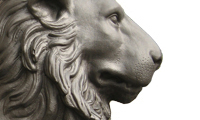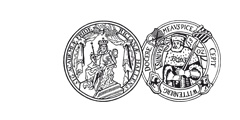Dr. Börge Göbel
Chiral Spin-Orbitronics

My research explores the interplay between topology and transport of charge, spin and orbital angular momentum. I investigate how topological spin textures, such as skyrmions, give rise to new, emergent phenomena. In several collaborations with experimentalists we explore new systems with a focus on two-dimensional materials. Besides doing fundamental research, I aim to contribute to the development of next-generation spintronic and orbitronic devices, with potential applications in quantum computing, memory storage, and neuromorphic computing.
I am currently funded by the EIC Pathfinder OPEN Grant "Orbital engineering for innovative electronics". Furthermore, I am the co-supervisor of a PhD student as part of the European Union's Horizon 2020 research and innovation program "Spin-orbit materials, emergent phenomena and related technologies".

Research profile: Börge Göbel
Kontakt
Dr. Börge Göbel
Raum 1.18c
Von-Seckendorff-Platz 1
06120 Halle (Saale)
Telefon: +49 (0) 345 55-25452
Telefax: +49 (0) 345 55-25446
boerge.goebel@physik.uni-halle.de
Research Highlights
Skyrmions and alternative magnetic quasiparticles
![From Göbel et al. [20] CC BY 4.0](/im/1602760996_2772_00_200.jpeg)
From Göbel et al. [20] CC BY 4.0
We analyze the stability and predict new non-collinear spin textures including skyrmions, antiskyrmions, antiferromagnetic skyrmions, bimerons, hopfions and others. Furthermore, we investigate their emergent electrodynamics such as the topological Hall effect, the magnetoelectric effect and their current-driven motion and propose their application in racetrack storages, for neuromorphic computing and other spin-orbitronic devices. The publications include collaborations with the groups of Prof. Stuart Parkin, Prof. Daniel Loss, Prof. Gen Tatara, Prof. Oleg Tretiakov and Prof. Christos Panagopoulos.
If you want to have an overview, feel free to read our review paper.
- Review Paper: Göbel et al. Physics Reports 895, 1 (2021)
- Fractional skyrmions: Jena, Göbel et al. Nat. Commun. 13, 2348 (2022)
- [Press release] Elliptical skyrmions: Göbel*, Jena* et al. Nat. Com. (2020)
- Prediction of bimerons: Göbel et al. Phys. Rev. B 99, 060407 (2019)
Orbitronics
![From Göbel et al. [40] CC BY 4.0](/im/1731933937_2772_00_200.png)
From Göbel et al. [40] CC BY 4.0
We investigate the orbital Hall effect, orbital magnetization and orbital Edelstein effect. We show that the famous quantum Hall effect is accompanied by an orbital Hall effect. Our quantum mechanical calculations fit well the semiclassical interpretation in terms of "skipping orbits". Likewise, the topological Hall effect of skyrmions is accompanied by a topological orbital Hall effect.
- [Press release] Orbital quantum Hall effect: Göbel et al. in PRL (2024)
- Orbital Hall effect of skyrmions: Göbel et al. in Comm. Phys. (2025)
- [Press release] Orbital Edelstein effect: Johansson, Göbel et al. PRR (2021)
Two-dimensional (2D) magnetism and electron gases
![From Göbel et al. [27] CC BY 4.0](/im/1731938207_2772_00_200.png)
From Göbel et al. [27] CC BY 4.0
We calculate the anomalous, spin and orbital Hall effect of coplanar spin textures in materials such as Mn3Sn. In an experimental collaboration with the groups of Prof. Stuart Parkin and Prof. Claudia Felser we have simulated and observed the switching of the non-collinear magnetic domains. Furthermore, we have observed non-collinear spin textures stabilized due to intercalation in van der Waals materials such as CrTe2 and Fe3GaTe2.
![From Göbel et al. [29] CC BY 4.0](/im/1731939372_2772_00_200.png)
From Göbel et al. [29] CC BY 4.0
In experimental collaborations with the groups of Dr. Manuel Bibes, Prof. Albert Fert, Dr. Laurent Vila and others, we model the electronic structure of two-dimensional electron gases, such as STO/AlO and KTO/AlO, and calculate their spin- and orbital-to-charge conversion to understand the experimental observations.
- [Press release] STO 2DEG: Göbel*, Vaz* et al. in Nature Materials (2019)
- Switching of Mn3Sn: Göbel*, Pal* et al. Sci. Adv. (2022)
- Observation of Rashba splitting: Göbel*, Varotto* et al. Nat. Com. (2022)
Publications
2025
[42] I. R. de Assis, I. Mertig, B. Göbel
RC circuit based on magnetic skyrmions
arXiv pre-print: 2411.13061 (2024)
[41] B. Göbel, L. Schimpf, I. Mertig
Topological orbital Hall effect caused by skyrmions and antiferromagnetic skyrmions
Communications Physics 8, 17 (2025)
2024
[40] B. Göbel, I. Mertig
Orbital Hall Effect Accompanying Quantum Hall Effect: Landau Levels Cause Orbital Polarized Edge Currents
Phys. Rev. Lett. 113, 146301 (2024)
[39] I. R. de Assis, I. Mertig, B. Göbel
Circular motion of noncollinear spin textures in Corbino disks: Dynamics of Néel- versus Bloch-type skyrmions and skyrmioniums
Phys. Rev. B 110, 064404 (2024)
[38] R. Saha, H. Meyerheim, B. Göbel, I. Mertig, S. Parkin
High-temperature Néel skyrmions in Fe3GaTe2 stabilized by Fe intercalation into the van der Waals gap
npj Spintronics 2, 21 (2024)
[37] G. Lazrak, B. Göbel, A. Barthélémy, I. Mertig, A. Johansson, M. Bibes.
Boosting the Edelstein effect of two-dimensional electron gases by ferromagnetic exchange
Phys. Rev. Res. 6, 023074 (2024)
[36] O. Busch, F. Ziolkowski, B. Göbel, I. Mertig, J. Henk
Ultrafast Orbital Hall Effect in Metallic Nanoribbons
Phys. Rev. Research 6, 013208 (2024)
2023
[35] S. Mallik*, B. Göbel*, H. Witt*, L. Vicente-Arche, S. Varotto, J. Bréhin, G. Ménard, G. Saďz, D. Tamsaout, A. Santander-Syro, F. Fortuna, F. Bertran, P. Le Fčvre, J. Rault, I. Boventer, I. Mertig, A. Barthélémy, N. Bergeal, A. Johansson, M. Bibes
Electronic band structure of superconducting KTaO3 (111) interfaces
APL Materials 11, 121108 (2023)
[34] I. Ribeiro de Assis, I. Mertig, B. Göbel
Skyrmion motion in magnetic anisotropy gradients: Acceleration caused by deformation
Physical Review B 108, 144438 (2023)
[33] O. Busch, I. Mertig, B. Göbel
Orbital Hall effect and orbital edge states caused by s electrons
Physical Review Research 5, 043052 (2023)
[32] V. Uzdin, D. Thonig, B. Göbel, P. Bessarab
Editorial: Nucleation and stability of exotic solitons in condensed matter
Frontiers in Physics 11, 1275990 (2023)
[31] B. Hazra, B. Pal, J.-C. Jeon, R. Neumann, B. Göbel, B. Grover, H. Deniz, A. Styervoyedov, H. Meyerheim, I. Mertig, S.-H. Yang, S. Parkin
Generation of out-of-plane polarized spin current by spin swapping
Nature Communications 14, 4549 (2023)
[30] I. Ribeiro de Assis, I. Mertig, B. Göbel
Biskyrmion-based artificial neuron
Neuromorphic Computing and Engineering 3, 014012 (2023)
2022
[29] S. Varotto*, A. Johansson*, B. Göbel*, L. Vicente-Arche, S. Mallik, J. Brehin, R. Salazar, F. Bertran, P. Fevre, N.Bergeal, J. Rault, I. Mertig, M. Bibes.
Direct visualization of Rashba-split bands and spin/orbital-charge interconversion at KTaO3 interfaces
Nature Communications 13, 6165 (2022)
[28] R. Saha, H. L. Meyerheim, B. Göbel, B. K. Hazra, H. Deniz, K. Mohseni, V. Antonov, A. Ernst, D. Knyazev, A. Bedoya-Pinto, I. Mertig, S. S. P. Parkin
Observation of Néel-type skyrmions in acentric self-intercalated Cr1+δTe2
Nature Communications 13, 3965 (2022)
[27] B. Pal*, B. K. Hazra*, B. Göbel*, J.-C. Jeon, A. K. Pandeya, A. Chakraborty, O. Busch, A. K. Srivastava, H. Deniz, J. M. Taylor, H. Meyerheim, I. Mertig, S.-H. Yang, S. S. P. Parkin.
Setting of the magnetic structure of chiral kagome antiferromagnets by a seeded spin-orbit torque.
Science Advances 8, eabo5930 (2022)
[26] J. Jena, B. Göbel, T. Hirosawa, S. Diaz, D. Wolf, T. Hinokihara, V. Kumar, I. Mertig, C. Felser, A. Lubk, D. Loss, S. Parkin.
Observation of fractional spin textures in a Heusler material.
Nature Communications 13, 2348 (2022)
2021
[25] O. Busch, B. Göbel, I. Mertig.
Spin Hall effect in noncollinear kagome antiferromagnets.
Physical Review B 104, 184423 (2021)
[24] B. Göbel, I. Mertig.
Quaternary-digital data storage based on magnetic bubbles in anisotropic materials.
Physical Review Applied 15, 064052 (2021)
[23] M. Raju, A. Petrović, A. Yagil, K. Denisov, N. Duong, B. Göbel, E. Şaşıoğlu, O. Auslaender, I. Mertig, I. Rozhansky, C. Panagopoulos.
Colossal topological Hall effect at the transition between isolated and lattice-phase interfacial skyrmions.
Nature Communications 12, 2758 (2021)
[22] A. Johansson, B. Göbel, J. Henk, M. Bibes, I. Mertig.
Spin and orbital Edelstein effects in a two-dimensional electron gas: Theory and application to SrTiO3 interfaces.
Physical Review Research 3, 013275 (2021)
[21] B. Göbel, I. Mertig.
Skyrmion ratchet propagation: Utilizing the skyrmion Hall effect in AC racetrack storage devices.
Scientific Reports 11, 3020 (2021)
[20] B. Göbel, I. Mertig, O. Tretiakov.
Beyond skyrmions: Review and perspectives of alternative magnetic quasiparticles.
Physics Reports 895, 1-28 (2021)
2020
[19] J. Jena*, B. Göbel*, V. Kumar, I. Mertig, C. Felser, S. Parkin.
Evolution and competition between chiral spin textures in nano-stripes with D2d symmetry.
Science Advances 6, eabc0723 (2020)
[18] P. Sivakumar, B. Göbel, E. Lesne, A. Markou, J. Gidugu, J. Taylor, H. Deniz, J. Jena, C. Felser, I. Mertig, S. Parkin.
Topological Hall Signatures of Two Chiral Spin Textures Hosted in a Single Tetragonal Inverse Heusler Thin Film.
ACS Nano 14, 13463 (2020)
[17] O. Busch, B. Göbel, I. Mertig.
Microscopic origin of the anomalous Hall effect in noncollinear kagome magnets.
Physical Review Research 2, 033112 (2020)
[16] B. Göbel, C. Akosa, G. Tatara, I. Mertig.
Topological Hall signatures of magnetic hopfions.
Physical Review Research 2 013315 (2020)
[15] J. Jena*, B. Göbel*, T. Ma, V. Kumar, R. Saha, I. Mertig, C. Felser, S. Parkin.
Elliptical Bloch skyrmion chiral twins in an antiskyrmion system.
Nature Communications 11, 1115 (2020)
[14] B. Göbel, A. Mook, J. Henk, I. Mertig.
Compensated Quantum and Topological Hall Effects of Electrons in Polyatomic Stripe Lattices.
Physica Status Solidi B 257, 1900518 (2020)
2019
[13] D. Vaz*, P. Noël*, A. Johansson*, B. Göbel*, F. Bruno, G. Singh, S. McKeown-Walker, F. Trier, L. Vicente-Arche, A. Sander, S. Valencia, P. Bruneel, M. Vivek, M. Gabay, N. Bergeal, F. Baumberger, H. Okuno, A. Barthélémy, A. Fert, L. Vila, I. Mertig, J. Attané, M. Bibes.
Mapping spin–charge conversion to the band structure in a topological oxide two-dimensional electron gas.
Nature Materials 18, 1187 (2019)
[12] B. Göbel*, A. F. Schäffer*, J. Berakdar, I. Mertig, S. S. P. Parkin.
Electrical writing, reading, and moving of magnetic skyrmioniums in a racetrack device.
Scientific Reports 9, 12119 (2019)
[11] B. Göbel, J. Henk, I. Mertig.
Forming magnetic biskyrmions by merging two skyrmions in a centrosymmetric nanodisk.
Scientific Reports 9, 9521 (2019)
[10] B. Göbel, A. Mook, J. Henk, I. Mertig, O. A. Tretiakov.
Magnetic bimerons as skyrmion analogues in in-plane magnets.
Physical Review B 99, 060407(R) (2019)
[9] B. Göbel, A. Mook, J. Henk, I. Mertig.
Magnetoelectric effect and orbital magnetization in skyrmion crystals: Detection and characterization of skyrmions.
Physical Review B 99, 060406(R) (2019)
[8] B. Göbel, A. Mook, J. Henk, I. Mertig.
Overcoming the speed limit in skyrmion racetrack devices by suppressing the skyrmion Hall effect.
Physical Review B 99, 020405(R) (2019)
2018
[7] B. Göbel, A. Mook, J. Henk, I. Mertig.
Publisher Correction to: The family of topological Hall effects for electrons in skyrmion crystals.
European Physical Journal B 91, 262 (2018)
[6] B. Göbel, A. Mook, J. Henk, I. Mertig.
The family of topological Hall effects for electrons in skyrmion crystals.
European Physical Journal B 91, 179 (2018)
[5] A. Mook, B. Göbel, J. Henk, I. Mertig.
Taking an electron-magnon duality shortcut from electron to magnon transport.
Physical Review B 97, 140401(R) (2018)
2017
[4] B. Göbel, A. Mook, J. Henk, I. Mertig.
Antiferromagnetic skyrmion crystals: Generation, topological Hall, and topological spin Hall effect.
Physical Review B 96, 060406(R) (2017)
[3] B. Göbel, A. Mook, J. Henk, I. Mertig.
Signatures of lattice geometry in quantum and topological Hall effect.
New Journal of Physics 19, 063042 (2017)
[2] B. Göbel, A. Mook, J. Henk, I. Mertig.
Unconventional topological Hall effect in skyrmion crystals caused by the topology.
Physical Review B 95, 094413 (2017)
[1] A. Mook, B. Göbel, J. Henk, I. Mertig.
Magnon transport in noncollinear spin textures: Anisotropies and topological magnon Hall effects.
Physical Review B 95, 020401(R) (2017)




